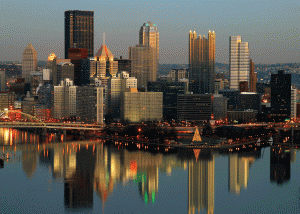Posts Tagged Pittsburgh Tuition Tax
Pittsburgh Needs a Regional Solution
Posted by admin in January 2010 on February 23, 2010
By Kollengode S. Venkataraman
 Recently, Pittsburgh Mayor Luke Ravenstahl’s proposal for a 1% tax on college tuition drew a lot of flak. Obviously, nobody likes taxes. As with many fiscal problems the nation is mired in, the fiscal problems of Pittsburgh have been growing for over two decades since the decline of the steel in the 1970s. All elected officials were only too aware of them.
Recently, Pittsburgh Mayor Luke Ravenstahl’s proposal for a 1% tax on college tuition drew a lot of flak. Obviously, nobody likes taxes. As with many fiscal problems the nation is mired in, the fiscal problems of Pittsburgh have been growing for over two decades since the decline of the steel in the 1970s. All elected officials were only too aware of them.
In many parts of the nation, during the years when oil was aplenty and inexpensive, the suburbs grew at the expense of the cities. There were also strong underlying social trends contributing to this: School busing, high crime rates in inner cities, and housing integration all contributed to what sociologists called the White Flight in which suburbs grew at the expense of cities. The graph below encapsulates this trend in our region.
The data for this plot were taken from http://www.spcregion.org,the website for the Southwestern Pennsylvania Commission, the forum for collaboration and public decision making. This forum comprising of elected officials from the ten counties around Allegheny County also has state and federal government officials. The other source for the data is of course the US Census Bureau. The following numbers are worth extracting from the plot.
We see that Pittsburgh’s population has disproportionately decreased from its peak when compared with the population declines in the region.
Secondly, nonprofit organizations — educational institutions, hospitals, places of worship, museums, recreational facilities, and many, many others — occupy a large chunk of real estate in town. The tax-exempt nonprofits, as elected officials have stressed, considerably reduce the city’s tax base.
To add to the city’s woes, a large number of suburbanites- estimated to be the entire population of the city – descend onto the city or drive through the city every day for work, recreation, and transacting business. This many number of people coming to the city every day drains a lot of city’s resources. The mayor simply can not pile more tax on city’s shrinking number of residents to fill the gap.
Yes, the city’s financial problems have been festering for a long time. But the tax-exempt nonprofits are not on moral high ground when they complain about the mayor’s 1% tax proposal on tuition.
The entire healthcare industry has been raising their charges on patients every year. Colleges and universities too have been continually raising their tuition to students. And the supposedly nonprofit UPMC makes obscene profits and has a huge and arguably aggressive presence in town.
The decline of steel in the 1970s devastated the entire region, and USAirways shutting down its hub at the Pittsburgh airport financially ruined the airport. So, we can argue that UPMC’s increasingly dominant presence may not be good for the city or for the healthcare industry in the region in the long run. Besides, the nonprofits are not living on shoestring budgets. The profligate management styles of the nonprofits and the salaries of their executives make one wonder if we need to change the definition of nonprofits for tax purposes. See Sally Kalson’s article UPMC: at odds with itself (www.post-gazette.com/pg/07140/787267-149.stm).
There are other solutions to the region’s problems. One is consolidating the 120-plus municipalities in Allegheny County into a SINGLE municipality. But given local politics and the refusal of the affluent neighborhoods to shoulder the region’s problems — even though they fully exploit and benefit from the city’s resources — we can as well wait for the Second Coming.
I’ve called Luke Ravenstahl “Fluke” Ravenstahl because he became the mayor by accident when Mayor Bob O’Conner suddenly died. Obviously, this epithet is misplaced because the mayor is expected to solve Pittsburgh’s huge financial mess. If anybody has a viable, equitable alternative to bridge the $15 million hole in the city’s budget, give him a call. He is all ears.
